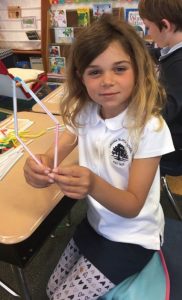We have been practicing our geometry skills this week in math. In first grade, much of our geometry work involves not only identifying shapes, but comparing them, categorizing them, and defining them.

Attribute blocks
The students were introduced to a new manipulative: attribute blocks. These blocks are similar to the pattern blocks with which you may be familiar, but they have subtle differences. Attribute blocks are various shapes and come in different colors and sizes. We use attribute blocks to practice identifying attributes!
First, we defined the word “attribute” and gave a few examples. For example, one attribute that several of our students share is brown hair. We applied this new vocabulary to our attribute blocks by noticing their shape, size, and color. To practice, we played the Attribute Train Game. Here’s how to play:
- The first player takes a block and puts it down to start a train.
- The second player chooses a block that is different in only one way – in shape, size, or color – from the first block. The second player adds that block to the train.
- Players continue taking turns until no more blocks can be played.

An attribute train game in progress
As students placed their blocks, they practiced identifying what was the same and what was different about their block choice.
Next, we used pattern blocks to practice identifying some standard shapes: triangles, squares, trapezoids, rhombuses, and hexagons. We learned to identify their defining attributes by starting sentences with “All squares have….” for example. We learned that all of our pattern block shapes belong to a group with a special name: polygons!

Ask your child to give you some examples of polygons along with some examples of shapes that are not polygons.
Today, we got creative and constructed polygons using pipe cleaners and 3 lengths of straws.

A student with her hexagon
Students constructed both regular and irregular polygons. They had a wonderful time figuring out what the name of their shape would be depending on how many sides it had. Several dodecagons (and beyond!) were created!

A student with his irregular decagon

A student with her irregular nonagon

A student with his regular pentagon

A student with his irregular pentagon

A student with her rhombus
Finally, students combined pattern blocks and some circle blocks to create composite shapes. They discovered that not all of their composite shapes fit the definition of a polygon, but some composite shapes did resemble familiar shapes we’ve seen.

Tracing a composite shape made out of three triangles

Discovering a hexagon made out of three rhombuses
Next week, we will be investigating the characteristics of some 3D shapes and learning the vocabulary associated with them.